MSI RTX 4080 Supreme X
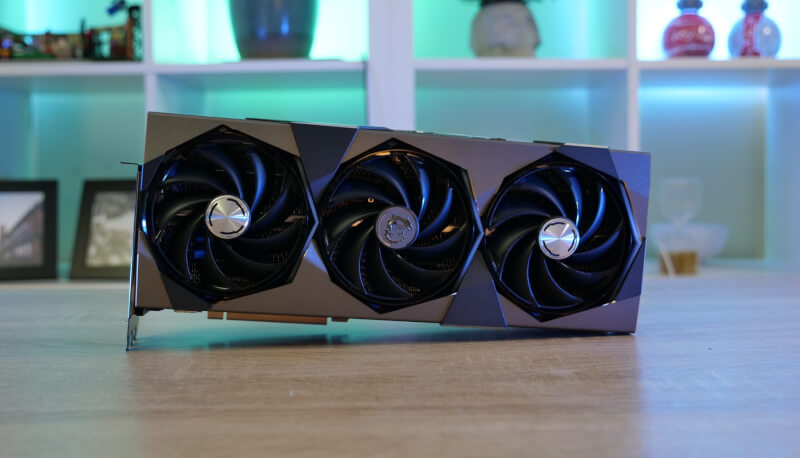
Specifications
- MODEL NAME: GeForce RTX™ 4080 16GB SUPRIM X
- GRAPHICS PROCESSING UNIT: NVIDIA® GeForce RTX™ 4080 16GB
- INTERFACE: PCI Express® Gen 4
- CORE CLOCKS: Extreme Performance: 2640 MHz / Boost: 2625 MHz (GAMING & SILENT Mode)
- CUDA® CORES: 9728 Units
- MEMORY SPEED: 22.4 Gbps
- MEMORY: 16GB GDDR6X
- MEMORY BUS: 256-bit
- OUTPUT: DisplayPort x 3 (v1.4a) HDMI™ x 1 (Supports 4K@120Hz HDR, 8K@60Hz HDR, and Variable Refresh Rate as specified in HDMI 2.1a)
- HDCP SUPPORT: Yes
- POWER CONSUMPTION: 320 W
- POWER CONNECTORS: 16-pin x 1
- RECOMMENDED PSU: 850 W (Minimum 750 W)
- CARD DIMENSION (MM): 336 x 142 x 78 mm
- WEIGHT (CARD / PACKAGE): 2364g / 3565g
- DIRECTX VERSION SUPPORT: 12 Ultimate
- OPENGL VERSION SUPPORT: 4.6
- MAXIMUM DISPLAYS: 4
- G-SYNC® TECHNOLOGY: Yes
- DIGITAL MAXIMUM RESOLUTION: 7680 x 4320
A Little About the Nvidia 4080 Chip
The new 4000 series of graphics cards from Nvidia is built on their new Ada Lovelace architecture. It is based on TMC's new 5nm 4N process, which unsurprisingly provides improved efficiency compared to the N7 process used on Nvidia's previous Ampere architecture.
The new series also comes with new 4th generation Tensor cores and 3rd generation RT cores, in addition to the new underlying process method. These elements should help to further boost performance, especially with regards to Ray Tracing and NVIDIA's DLSS.
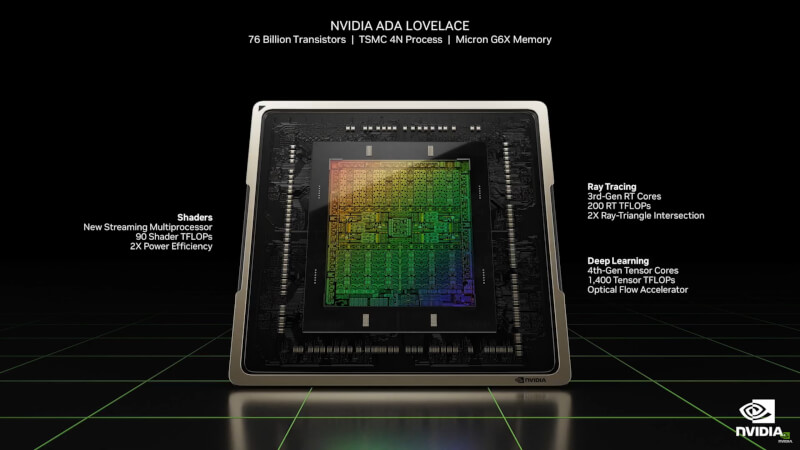
Ray Tracing is undoubtedly here to stay, and the visual effect can be incredibly great in games that support and implement it well. However, it is still a technology that requires a powerful graphics card if it is to run at framerates that can come close to matching the non Ray Tracing alternative.
With the new architecture and improved DLSS and RT Cores, Nvidia is now betting on Ada Lovelace and the RTX 4000 series to give a boost to Ray Tracing and make it more mainstream than it has been previously.
A Tour Around MSI RTX 4080 Suprim X
The first thing you notice about the RTX 4080 Suprim X card is its size. The previous generation of top cards was not exactly small, but with the 4080 card here things take a new turn in size.
The card comes in with a weight of almost 2.5 kg and a length of just under 34 cm. This means that one should be aware that they may have space issues in more compact cabinets.
If we look past the size and focus on the design, MSI graphics card enthusiasts will feel right at home. The design has not changed significantly from previous generations of Suprim and Gaming X Trio cards.
There is more refinement and fewer adjustments, than big changes that characterize this map. We get surfaces in brushed aluminum and sharp angles.
MSI's Tri Frozr 3S solution takes care of the cooling. It uses three Torx 5.0 fans, which MSI claims will significantly improve the airflow to the card.
The fans provide air to the massive cooler, which makes use of a Vapor Chamber solution on the GPU core and VRAM sections of the card. They are connected to seven heatpipes, and a large stack of cooling fins, all of which work together to quickly draw heat away from the hot components of the card.
Despite the large size of the graphics card, the card itself is actually not that big again. The cooler is a good deal longer than the card itself.
Of course, there is RGB lighting on the card, which is divided into three zones. There is light at each of the three Torx 5.0 fans, as well as in the MSI Suprim logo on the side of the card.
The power to the card is supplied by the new 12VHPWR cable. It is part of the new PCIe 5.0 standard, and will eventually become a standard component of new power supplies. Some power supply manufacturers offer 12VHPWR cables for existing power supplies that are compatible.
An adapter is included in the box for the MSI RTX 4080 Suprim X card. It can be used to connect three regular 8 pins PCIe connectors, providing power to the 12VHPWR socket on the card.
One should be aware, however, that if the adapter is used, the card will become slightly wider. This means that an already wide card may become even more difficult to fit.
Looking at the connections, the card comes with one HDMI 2.1a and three DisplayPort 1.4a. Additionally, it is a 3.5 slot card, so the RTX 4080 Suprim X card takes up a lot of space.
On the back of the card, it is supplied with a metal backplate, in the same brushed look as the rest of the card. It helps to create a sleek and cohesive look.
On this page, we can also see a small contact that can be used to switch between the two BIOS settings that the card is equipped with. There is a gaming and a Silent profile. Of course, I have done all the tests on the Gaming profile.
The build quality and materials are all around really good. MSI has created a beautiful and complete card with the RTX 4080 Suprim X. It is undoubtedly a large card, so it will be interesting to see if it delivers performance that justifies its massive size.
Testing
Although it is naturally nice to have a card that looks good in the machine, it is of course the performance that must justify the price of a new graphics card. Therefore, we must of course also test the card. This was done on our AMD Ryzen based open bed test bench, with the following hardware:
- Motherboard: MSI MEG X570 Godlike
- CPU: AMD Ryzen 7 3700X
- RAM: 32 GB G.Skill Trident Z @3200 MHz
The first item on the agenda, as always, is to find a baseline for both clock speeds, temperature, and noise. This is done with a Unigine Heaven stress test, which I will let run for 30 minutes.
Her MSI RTX 4080 Suprim X card arrived with an average clock speed of 2825 MHz, which is a good tooth above the advertised 2640 MHz. The temperature topped out at 55 degrees, and the overall noise level ended at 38 dBA.
Both aspects are extremely satisfying, and it actually means that the card is one of the quietest cards I have tested to date.
3D Mark
Afterwards, the journey continued to the synthetic 3D Mark Benchmarks. I started with Firestrike Extreme. Here, the Suprim X card came in with an overall score of 26057, placing it with a good lead ahead of the other cards I have chosen to compare in the test.

The results of the Time Spy test yielded a score of 19841 points. This is a score that once again places the RTX 4080 Suprim X card with a good lead, over the cards it is being compared to.
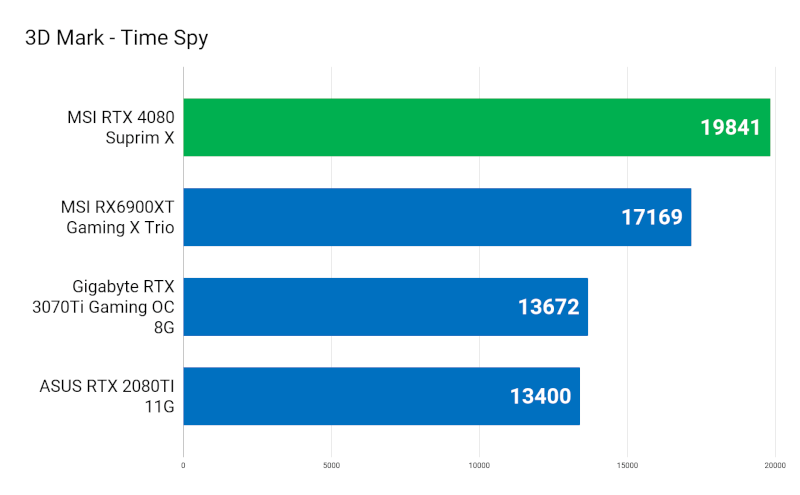
Split Test
We move on to our gaming test to see how the card performs. All tests here are performed without the use of DLSS, render scaling, or other similar technologies, so it is a test of pure raw performance.
Cyberpunk 2077
- High Preset - No DLSS - No AMD FidelityFX - Dynamic Resolution Scaling = OFF
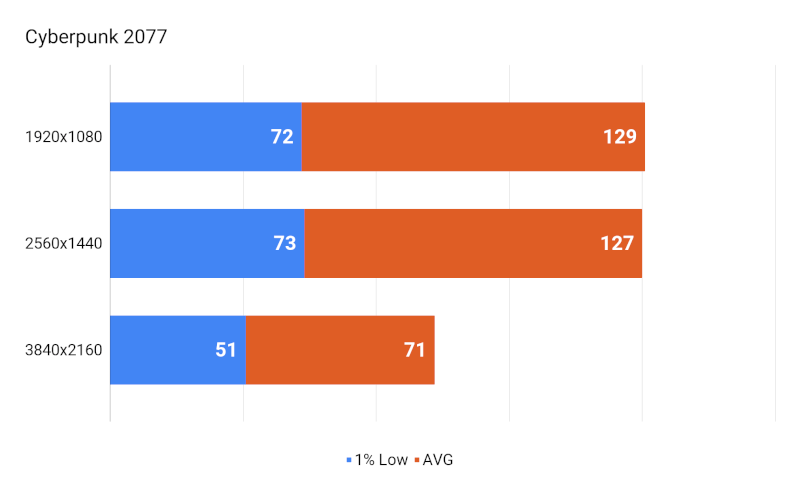
We can see here that the RTX 4080 Suprim X card packs a lot of power. Cyberpunk 2077 is one of the most demanding games on the market right now. Even at 4K resolution, we are doing really well and comfortably over 60 FPS.
It is noteworthy, however, that there is virtually no difference between 1440p and 1080p resolutions.
.png)
When we look at the comparison, we can see that the card with 4080 is far ahead of the other cards we have compared it with. All of these cards, otherwise, perform poorly when isolated.
Assassin's Creed Valhalla
- High Preset - Resolution Scale set to 100% - Adaptive Quality turned OFF
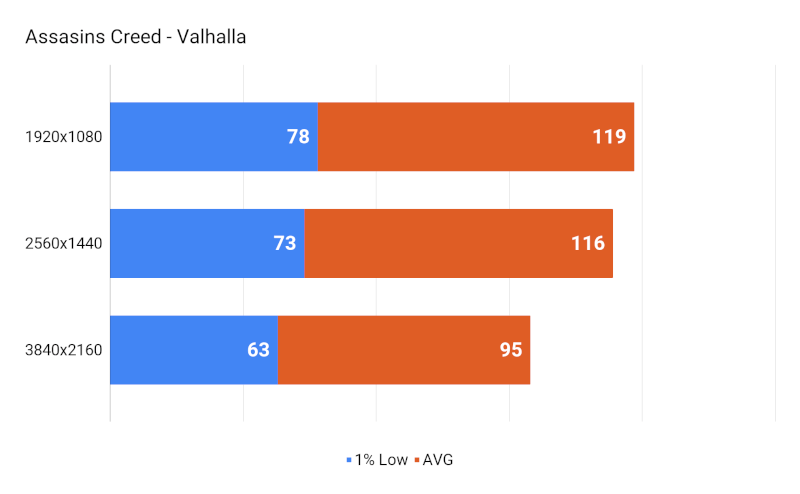
Assassin's Creed Valhalla is also on the heavier side, but not quite on par with Cyberpunk. The results look really solid across all three tested resolutions. However, there is not much difference to be gained between 1440p and 1080p.
.png)
In the comparison, we can see that Suprim X is still comfortably in the lead, even though the RX 6900XT card is not far behind. However, this has more to do with the game than the cards' direct relationship.
Outriders
- Ultra Preset - DLSS: OFF - Resolution Scaling: 100%
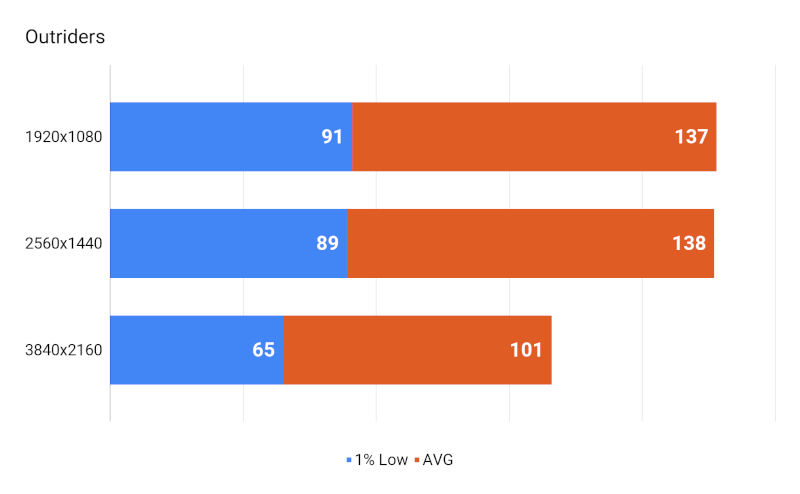
Outriders is a beautiful game but more forgiving than the heavier ones in our test. Here we can see really good results with over 100 FPS even in 4K. The results are almost identical between 1440p and 1080p, which could indicate that we are landing around the upper limit of the game engine.
.png)
In the comparison, we are still in the lead with the Supreme card, but the biggest difference between the more powerful cards is not surprisingly seen in 4K resolution.
Overwatch 2
- Ultra Preset - Render Scale: 100% - Dynamic Render Scale: OFF - High Quality Upsampling: OFF
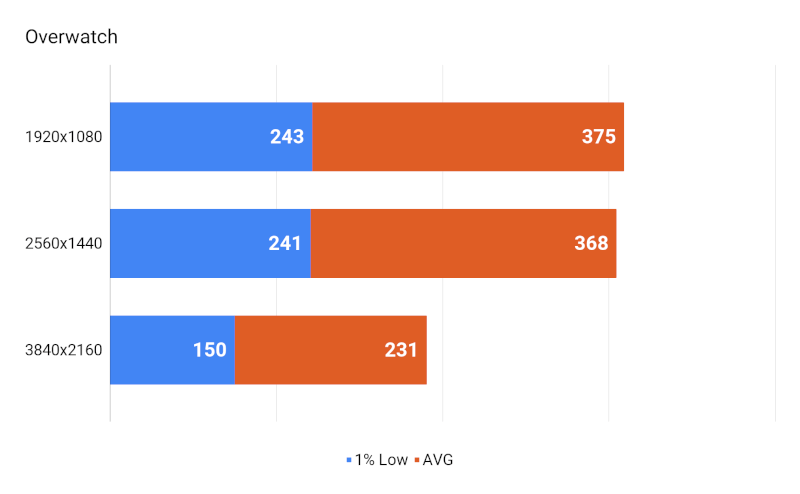
Without a doubt, Overwatch 2 is the easiest title in our test set. However, as a competitive shooter, it is also one of those where most people would prefer higher frame rates.
Our results show, unsurprisingly, that the Suprim X card can certainly keep up here. Solidly over 200 FPS, even in 4K, should be enough to satisfy most.
.png)
In the comparison, the RTX 4080 Suprim X wins again. However, we can see from the comparison that even older cards can relatively easily chew through Overwatch 2.
Ray Tracing
Until now, we have not tested Ray Tracing performance when testing graphics cards. This has been due to the argument that it has been quite limited in terms of how widespread it is and how many cards support it in a reasonable way.
With the new 4000 series of cards from Nvidia, and the improvements that time has brought, we have decided to take it on. That way, hopefully you can get some idea of how the cards we test going forward compare to each other in terms of Ray Tracing performance.
Testing Ray Tracing can be quite difficult due to the fact that there are almost as many implementations of Ray Tracing as there are games that support it. It is not a unified package, and game developers can choose to use very few, or all of the options available in Ray Tracing.

Therefore, the hardware requirements can vary greatly from game to game, even when playing with Ray Tracing enabled in them all. For our Ray Tracing tests, we have chosen to test with Cyberpunk 2077. We do this because it is one of the games on the market today that has the most comprehensive Ray Tracing support. This means that it is a game that can provide a good basis for deeper tests of Ray Tracing, if we need to do a more thorough test of it at a later time.
It is also important to emphasize that this test, like the other tests, is only a snapshot of the performance based on the game and settings we have tested with. This is not the definitive answer to how good a graphics card is for Ray Tracing. The test is done to give an idea of the relative strengths of the tested cards in a selection of games.
We hope, however, that the test can be used as a basis for comparison between RT performance on different cards. All tests were also carried out without the use of DLSS, AMD Fidelity FX or other similar technologies or render scaling.
So, this is pure raw Ray Tracing performance, without any help from any of the tools.
Cyberpunk 2077 - Ray Tracing
- Ray Tracing Medium Preset, No DLSS, No AMD FidelityFX, Dynamic Resolution Scaling is OFF
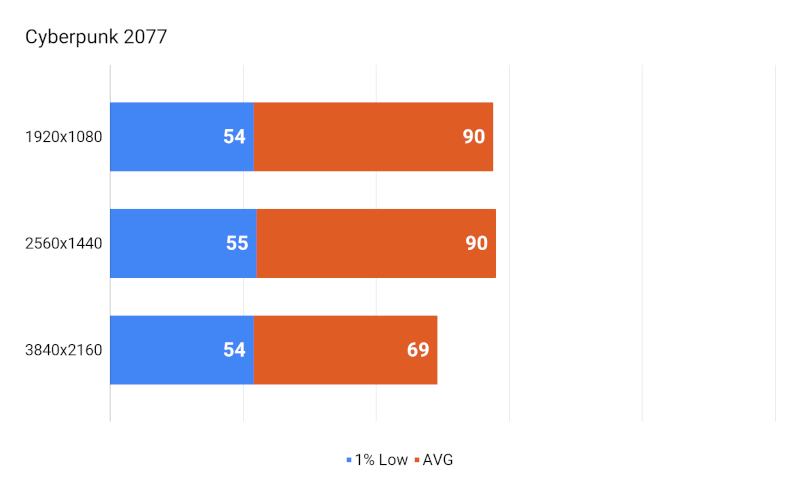
The results on Medium Ray Tracing settings are quite reasonable. Notably, there is almost no difference between Ray Tracing and the regular settings at 4K. This puzzled me and prompted further tests, which, however, yielded the same result repeatedly.
The difference in performance between 1440p and 1080p is much more pronounced. Again, it is strange that the results are almost identical. Again, this was a result that repeated itself in multiple tests.
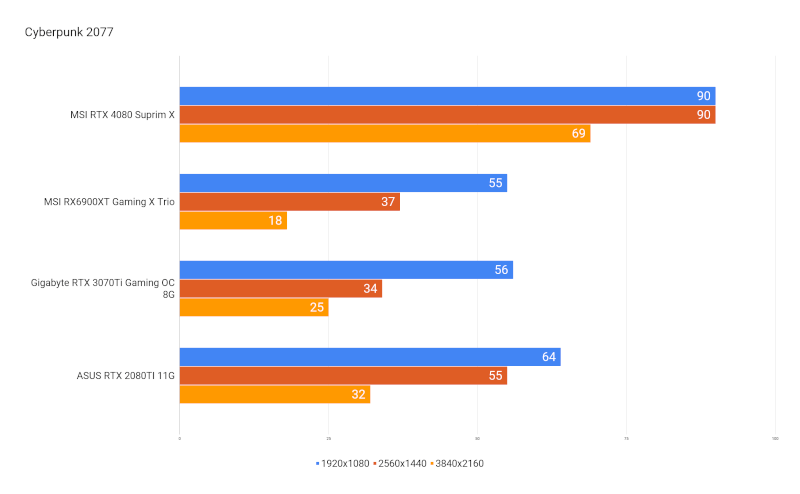
When we look at the comparison, with the other cards in our setup, we can clearly see that a lot has changed with the new generation from Nvidia. The new RT cores and the general technology improvement seem to be doing well for the Ray Tracing results.
Price
The new generation from Nvidia is expensive. The cheapest price I can currently find for the MSI RTX 4080 Suprim X card is just under $1,800 USD.
Conclusion
MSI has created a beautiful card with their RTX 4080 Suprim X. The new Nvidia hardware has been assembled by MSI with a solid cooling solution that keeps the card cool and quiet under load. In fact, it is the quietest card I have tested.
When looking at the performance in isolation, there is not much to complain about, as the card can handle even demanding games at high settings without any issues with sound or heat.
Unfortunately, we have not had the opportunity to test the RTX 4090 card yet, but looking at other tests, it is naturally where the ultimate performance is currently located. However, it is also with a price that lies on the expensive side of $2,550 USD.
It is always difficult to value a card in this class, as the target group is quite small. Cards in this class are for the most hardcore hardware and gaming fans. My assessment is that by FAR the majority of hobby gamers can get by with FAR less, if they are just a little sensible and practical. If one is in the group of people who want the latest tech, with a budget of around $1,800 Danish Kroner but not $2,550 USD, then RTX 4080 is the place to be. As I mentioned earlier, this is likely a fairly narrow group.
If one is in that group, I would almost suggest that they should save a little extra and go for an RTX 4090. Here, there is a good bit more performance to be gained for relatively few extra dollars.
When looking at it in isolation, there is undoubtedly good performance to be had with the MSI RTX 4080 Suprim X. But when looking at it more broadly and with "value" glasses on, in terms of anything other than the actual price in kroner and øre, then there is much more sensible value to be found in the older generations for most people.
We give a final rating of 8 for a technically sound product, however it should be thoroughly considered before purchase.
Good:
- Fantastic Design
- Quiet and Cool
Bad:
- Price/Value compared to previous generation
Latest graphics card
-
20 Margraphics card
-
13 Jangraphics card
ASRock B580 Steel Legend
-
07 Jangraphics card
ASUS showcases new AMD RX 9700 graphics cards
-
07 Jangraphics card
ASUS ready with large selection of RTX 50 graphics
-
07 Jangraphics card
Nvidia Reflex 2 reduces gaming latency
-
07 Jangraphics card
Nvidia launches DLSS 4 with the new RTX 50 series
-
07 Jangraphics card
Nvidia RTX 50 series is ready
-
07 Jangraphics card
Nvidia launches RTX 5090 at CES
Most read graphics card
Latest graphics card
-
20 Margraphics card
ASRock RX 9070 Steel Legend
-
13 Jangraphics card
ASRock B580 Steel Legend
-
07 Jangraphics card
ASUS showcases new AMD RX 9700 graphics cards
-
07 Jangraphics card
ASUS ready with large selection of RTX 50 graphics
-
07 Jangraphics card
Nvidia Reflex 2 reduces gaming latency
-
07 Jangraphics card
Nvidia launches DLSS 4 with the new RTX 50 series
-
07 Jangraphics card
Nvidia RTX 50 series is ready
-
07 Jangraphics card
Nvidia launches RTX 5090 at CES






